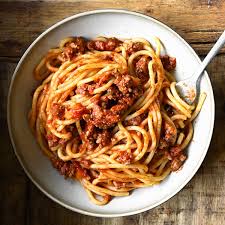The Delightful World of Spaghetti
Spaghetti, a staple in Italian cuisine, has captured the hearts and taste buds of people around the globe. This versatile pasta is loved for its simplicity, yet it can be transformed into a myriad of delicious dishes that cater to every palate.
Originating from Italy, spaghetti is long, thin pasta made from durum wheat semolina. Its name comes from the Italian word “spaghetto,” which means “thin string” or “twine.” The classic way to enjoy spaghetti is by pairing it with a rich tomato sauce and perhaps some meatballs, creating the beloved spaghetti and meatballs dish.
However, spaghetti’s versatility knows no bounds. It can be dressed with creamy Alfredo sauce, savory pesto, or zesty marinara. Seafood lovers rejoice in dishes like spaghetti alle vongole (with clams) or spaghetti ai frutti di mare (with mixed seafood).
For those seeking a lighter option, spaghetti aglio e olio (with garlic and olive oil) offers a simple yet flavorful alternative. Vegetarians can indulge in spaghetti primavera loaded with fresh vegetables and herbs.
Whether twirled on a fork or slurped up enthusiastically, spaghetti brings people together around the dinner table. Its comforting texture and ability to absorb flavors make it a beloved choice for family meals and romantic dinners alike.
So next time you’re craving a hearty and satisfying meal, consider diving into the delightful world of spaghetti. With endless possibilities for creativity and flavor combinations, there’s always something new to discover and savor with this beloved pasta.
6 Essential Tips for Perfectly Cooked Spaghetti
- Use a large pot with plenty of water to cook spaghetti.
- Add salt to the boiling water before adding the spaghetti for flavor.
- Stir the spaghetti immediately after adding it to prevent sticking.
- Cook spaghetti until ‘al dente’ for the best texture.
- Save some pasta water before draining to use in sauces for added flavor and thickness.
- Toss cooked spaghetti with sauce off heat to ensure even coating.
Use a large pot with plenty of water to cook spaghetti.
When preparing spaghetti, it’s essential to use a large pot with an ample amount of water for cooking. By using a large pot, you ensure that the spaghetti has enough space to move freely and cook evenly. This method helps prevent the pasta from sticking together and ensures that it cooks to the perfect al dente texture. Additionally, using plenty of water allows the pasta to boil properly and helps maintain the ideal temperature throughout the cooking process. So, remember to reach for that big pot and fill it with water before you embark on creating your delicious spaghetti dish.
Add salt to the boiling water before adding the spaghetti for flavor.
To enhance the taste of your spaghetti, a simple yet effective tip is to add salt to the boiling water before introducing the pasta. This step not only seasons the spaghetti from within but also infuses it with a subtle depth of flavor. The salted water permeates the pasta as it cooks, ensuring that each strand is perfectly seasoned, resulting in a more delicious and well-rounded dish. Next time you’re cooking spaghetti, don’t forget this easy trick to elevate your meal to new flavorful heights.
Stir the spaghetti immediately after adding it to prevent sticking.
To prevent sticking, it is essential to stir the spaghetti immediately after adding it to the boiling water. This simple tip ensures that the pasta separates and cooks evenly, resulting in perfectly al dente noodles ready to be paired with your favorite sauce. By giving the spaghetti a quick stir right from the start, you can enjoy a hassle-free cooking process and a delicious plate of pasta every time.
Cook spaghetti until ‘al dente’ for the best texture.
For the best texture and flavor when cooking spaghetti, it is essential to cook it until ‘al dente,’ which translates to “to the tooth” in Italian. This means that the pasta should be firm to the bite, with a slight resistance when chewed. Cooking spaghetti to al dente ensures that it retains a pleasant texture and doesn’t become mushy or overcooked. This simple tip can elevate your spaghetti dishes, providing a satisfying and authentic dining experience that truly celebrates the essence of this beloved pasta.
Save some pasta water before draining to use in sauces for added flavor and thickness.
To enhance the flavor and texture of your pasta dishes, consider saving some pasta water before draining. This simple tip can elevate your sauces by adding a depth of flavor and a velvety thickness. The starchy water from cooking the pasta acts as a natural thickener and helps bind the sauce to the noodles, creating a harmonious and cohesive dish. Next time you’re preparing spaghetti, don’t overlook this trick – a small amount of pasta water can make a big difference in the overall taste and quality of your meal.
Toss cooked spaghetti with sauce off heat to ensure even coating.
To ensure a perfectly coated dish of spaghetti, a helpful tip is to toss the cooked pasta with the sauce off the heat. This technique allows the sauce to evenly coat each strand of spaghetti, ensuring that every bite is bursting with flavor. By combining the pasta and sauce off the heat, you create a harmonious blend that enhances the overall taste experience. So, next time you’re cooking spaghetti, remember this simple yet effective tip for a delicious and well-balanced meal.

